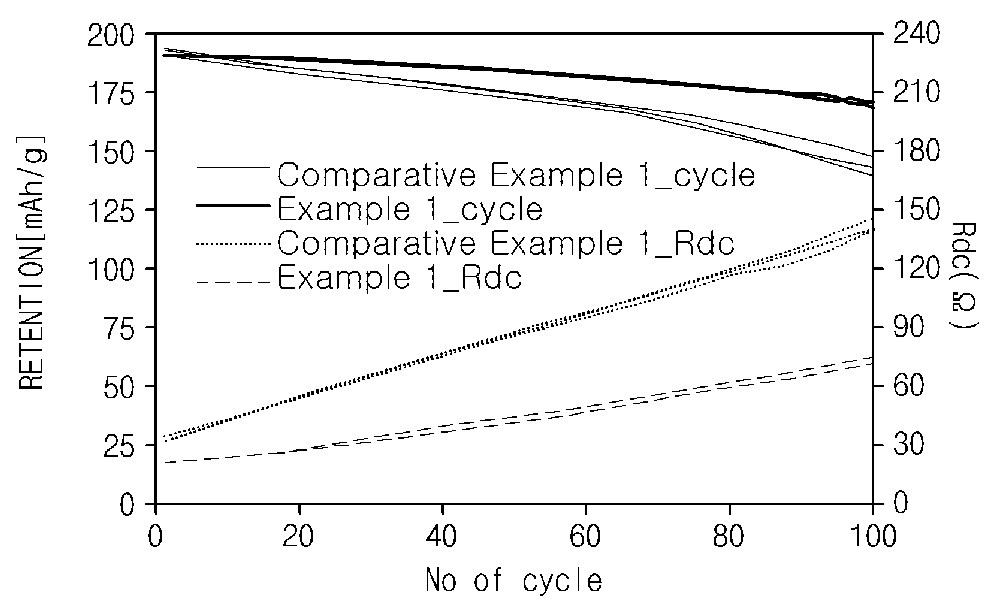Positive electrode active material for lithium secondary battery, method of preparing the same, and positive electrode for lithium secondary battery and lithium secondary battery which include the positive electrode active material
a lithium secondary battery and active material technology, applied in the direction of cell components, electrochemical generators, nickel compounds, etc., can solve the problems of limited use of a large amount of licoosub>2 as a power source for electric vehicles, poor thermal properties of licoosub>2 /sub>, and poor so as to improve the mobility of lithium ions, improve the structural stability of lithium transition metal oxide, and improve the effect of life characteristics
- Summary
- Abstract
- Description
- Claims
- Application Information
AI Technical Summary
Benefits of technology
Problems solved by technology
Method used
Image
Examples
example 1
[0091]After mixing 300 g of LiNi0.8Co0.1Mn0.1Zr0.04S0.03O2 with 100 mL of H3BO3 having a pH of 6, the mixture was subjected to a reaction for 1 hour to form Li3BO3 on a surface of the LiNi0.8Co0.1Mn0.1Zr0.04S0.03O2. The product thus obtained was dried at 150° C. and then heat-treated at 300° C. to prepare a positive electrode active material in which a 10 nm thick Li—B—O compound layer including Li3BO3 and LiBO2 was formed on a surface of the LiNi0.8Co0.1Mn0.1Zr0.04S0.03O2.
[0092]The above-prepared positive electrode active material, a carbon black conductive agent, and a PVdF binder were mixed in a weight ratio of 95:2.5:2.5 in an N-methylpyrrolidone solvent to prepare a composition for forming a positive electrode. A 20 μm thick Al current collector was coated with the composition for forming a positive electrode, dried, and then roll-pressed to prepare a positive electrode.
[0093]Lithium metal was used as a counter electrode.
[0094]After the above-prepared positive electrode and the...
example 2
[0095]A positive electrode and a lithium secondary battery including the same were prepared in the same manner as in Example 1 except that a positive electrode active material was used in which, after mixing 300 g of LiNi0.8Co0.1Mn0.1Zr0.04S0.03O2 with 100 mL of H3PO4 having a pH of 3, the mixture was subjected to a reaction for 1 hour to form a Li3PO4 layer on the surface of the positive electrode active material.
experimental example 1
Life Characteristics and Resistance Characteristics Evaluation
[0100]Life characteristics and resistance characteristics were measured for each of the lithium secondary batteries prepared in Example 1 and Comparative Example 1.
[0101]Specifically, each of the secondary batteries prepared in Example 1 and Comparative Example 1 was charged at a constant current of 1 C to 4.4 V at 25° C. and cut-off charged at 0.05 C. Thereafter, each secondary battery was discharged at a constant current of 1 C to a voltage of 3 V. The charging and discharging behaviors were set as one cycle, and, after this cycle was repeated 100 times, capacity and resistance increase rates of the lithium secondary batteries according to Example 1 and Comparative Example 1 were measured. The life characteristics and resistance characteristics of Example 1 and Comparative Example 1 measured in Experimental Example 1 are presented in FIG. 1 and Table 1 below.
[0102]
TABLE 1Capacity inthe 100th cycleRde(mAh / g)(Ohm)Example ...
PUM
| Property | Measurement | Unit |
|---|---|---|
| thickness | aaaaa | aaaaa |
| pH | aaaaa | aaaaa |
| thickness | aaaaa | aaaaa |
Abstract
Description
Claims
Application Information
 Login to View More
Login to View More - R&D
- Intellectual Property
- Life Sciences
- Materials
- Tech Scout
- Unparalleled Data Quality
- Higher Quality Content
- 60% Fewer Hallucinations
Browse by: Latest US Patents, China's latest patents, Technical Efficacy Thesaurus, Application Domain, Technology Topic, Popular Technical Reports.
© 2025 PatSnap. All rights reserved.Legal|Privacy policy|Modern Slavery Act Transparency Statement|Sitemap|About US| Contact US: help@patsnap.com

